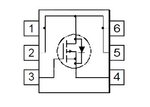rosmawati
Member level 1
- Joined
- Jan 5, 2009
- Messages
- 34
- Helped
- 2
- Reputation
- 4
- Reaction score
- 1
- Trophy points
- 1,288
- Location
- Penang, Malaysia
- Activity points
- 1,542
Hi,
I would like to confirm my circuit design.
What I planned to do is some kind of switching circuit. It's just that I got confused between drain and source pin of the MOSFET. I've been doing some reading on the net but so far I'm still lost. Did I really hook the connections correctly?
Need your help guys.
Thanks in advance.
I would like to confirm my circuit design.
What I planned to do is some kind of switching circuit. It's just that I got confused between drain and source pin of the MOSFET. I've been doing some reading on the net but so far I'm still lost. Did I really hook the connections correctly?
Need your help guys.
Thanks in advance.


